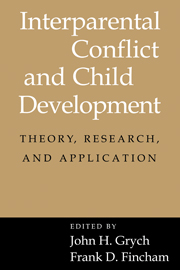Book contents
- Frontmatter
- Contents
- List of Contributors
- Preface
- Interparental Conflict and Child Adjustment: An Overview
- Part One Foundations
- Part Two Basic Processes
- Part Three Family and Peer Contexts
- 9 Interparental Conflict and Parent–Child Relationships
- 10 Sibling Relationships and Interparental Conflict
- 11 Managing Marital Conflict: Links with Children's Peer Relationships
- 12 Domestic Violence and Child Adjustment
- 13 When Conflict Continues after the Marriage Ends: Effects of Postdivorce Conflict on Children
- 14 Marital Conflict in Stepfamilies
- Part Four Applications
- Part Five Future Directions
- Author Index
- Subject Index
10 - Sibling Relationships and Interparental Conflict
Published online by Cambridge University Press: 01 May 2010
- Frontmatter
- Contents
- List of Contributors
- Preface
- Interparental Conflict and Child Adjustment: An Overview
- Part One Foundations
- Part Two Basic Processes
- Part Three Family and Peer Contexts
- 9 Interparental Conflict and Parent–Child Relationships
- 10 Sibling Relationships and Interparental Conflict
- 11 Managing Marital Conflict: Links with Children's Peer Relationships
- 12 Domestic Violence and Child Adjustment
- 13 When Conflict Continues after the Marriage Ends: Effects of Postdivorce Conflict on Children
- 14 Marital Conflict in Stepfamilies
- Part Four Applications
- Part Five Future Directions
- Author Index
- Subject Index
Summary
In this chapter, we consider the links between interparental conflict and sibling relationships. Why a focus on siblings? Differences in the quality of sibling relationships are marked both across families and within families. Some siblings quarrel fiercely and frequently; among others, hostility, irritability, and fighting are rare, and affection, intimacy, and cooperation are the key features of their relationship. Yet other siblings show both affection and conflict in their relationships: They argue frequently but are also good companions and friends. These differences are evident in siblings in very early childhood, in middle childhood and adolescence, and can show considerable continuity over time (Dunn, Slomkowski, Beardsall, & Rende, 1994b). Importantly, such individual differences in siblings' relations are related to two key aspects of children's development.
The first is children's adjustment. The shaping role of siblings on children's aggressive behavior, for instance, has been documented by Patterson and his colleagues (Bank, Patterson, & Reid, 1996; Patterson, 1986). Aggressive experiences with siblings were linked with children's aggressive behavior with their peers, and with rejection by peers in MacKinnon-Lewis et al.'s study (1997). And both internalizing and externalizing behavior problems in middle childhood and early adolescence have been found to be associated with individual differences in sibling relationships years earlier – in the preschool period (Dunn et al., 1994b). Negative relations between siblings have been linked to adjustment problems in a recent large-scale community study (Dunn et al., 1998), whereas within stepfamilies, sibling negativity has also been linked with later increases in externalizing behavior (Hetherington & Clingempeel, 1992).
- Type
- Chapter
- Information
- Interparental Conflict and Child DevelopmentTheory, Research and Applications, pp. 273 - 290Publisher: Cambridge University PressPrint publication year: 2001
- 13
- Cited by

